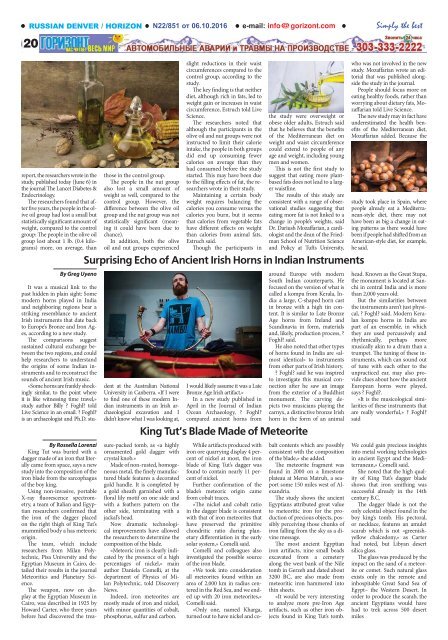Горизонт N22/851
Горизонт (газета) — (Gorizont англ. Horizon ) первая и наиболее влиятельная газета, издающаяся на русском языке в штатеКолорадо, США. Еженедельник, выходит по пятницам, формат Таблоид, 128 цветных и чернобелых страниц, распространяется в городах, составляющих метрополию Денвера (Большой Денвер), и в других населенных пунктах штата Колорадо от графства Саммит до графства Эль—Пасо. Полная электронная версия газеты «Горизонт» доступна в сети Интернет. Подробнее http://en.wikipedia.org/wiki/Gorizont_(newspaper)
Горизонт (газета) — (Gorizont англ. Horizon ) первая и наиболее влиятельная газета, издающаяся на русском языке в штатеКолорадо, США. Еженедельник, выходит по пятницам, формат Таблоид, 128 цветных и чернобелых страниц, распространяется в городах, составляющих метрополию Денвера (Большой Денвер), и в других населенных пунктах штата Колорадо от графства Саммит до графства Эль—Пасо. Полная электронная версия газеты «Горизонт» доступна в сети Интернет. Подробнее http://en.wikipedia.org/wiki/Gorizont_(newspaper)
You also want an ePaper? Increase the reach of your titles
YUMPU automatically turns print PDFs into web optimized ePapers that Google loves.
RUSSIAN DENVER / HORIZON<br />
<strong>N22</strong>/<strong>851</strong> от 06.10.2016 e-mail: info@gorizont.com Simply the best<br />
20<br />
report, the researchers wrote in the<br />
study, published today (June 6) in<br />
the journal The Lancet Diabetes &<br />
Endocrinology.<br />
The researchers found that after<br />
five years, the people in the olive<br />
oil group had lost a small but<br />
statistically significant amount of<br />
weight, compared to the control<br />
group: The people in the olive oil<br />
group lost about 1 lb. (0.4 kilograms)<br />
more, on average, than<br />
those in the control group.<br />
The people in the nut group<br />
also lost a small amount of<br />
weight as well, compared to the<br />
control group. However, the<br />
difference between the olive oil<br />
group and the nut group was not<br />
statistically significant (meaning<br />
it could have been due to<br />
chance).<br />
In addition, both the olive<br />
oil and nut groups experienced<br />
slight reductions in their waist<br />
circumferences compared to the<br />
control group, according to the<br />
study.<br />
The key finding is that neither<br />
diet, although rich in fats, led to<br />
weight gain or increases in waist<br />
circumference, Estruch told Live<br />
Science.<br />
The researchers noted that<br />
although the participants in the<br />
olive oil and nut groups were not<br />
instructed to limit their calorie<br />
intake, the people in both groups<br />
did end up consuming fewer<br />
calories on average than they<br />
had consumed before the study<br />
started. This may have been due<br />
to the filling effects of fat, the researchers<br />
wrote in their study.<br />
Maintaining a certain body<br />
weight requires balancing the<br />
calories you consume versus the<br />
calories you burn, but it seems<br />
that calories from vegetable fats<br />
have different effects on weight<br />
than calories from animal fats,<br />
Estruch said.<br />
Though the participants in<br />
the study were overweight or<br />
obese older adults, Estruch said<br />
that he believes that the benefits<br />
of the Mediterranean diet on<br />
weight and waist circumference<br />
could extend to people of any<br />
age and weight, including young<br />
men and women.<br />
This is not the first study to<br />
suggest that eating more plantbased<br />
fats does not lead to a larger<br />
waistline.<br />
The results of this study are<br />
consistent with a range of observational<br />
studies suggesting that<br />
eating more fat is not linked to a<br />
change in people’s weights, said<br />
Dr. Dariush Mozaffarian, a cardiologist<br />
and the dean of the Friedman<br />
School of Nutrition Science<br />
and Policy at Tufts University,<br />
Surprising Echo of Ancient Irish Horns in Indian Instruments<br />
who was not involved in the new<br />
study. Mozaffarian wrote an editorial<br />
that was published alongside<br />
the study in the journal.<br />
People should focus more on<br />
eating healthy foods, rather than<br />
worrying about dietary fats, Mozaffarian<br />
told Live Science.<br />
The new study may in fact have<br />
underestimated the health benefits<br />
of the Mediterranean diet,<br />
Mozaffarian added. Because the<br />
study took place in Spain, where<br />
people already eat a Mediterranean-style<br />
diet, there may not<br />
have been as big a change in eating<br />
patterns as there would have<br />
been if people had shifted from an<br />
American-style diet, for example,<br />
he said.<br />
By Greg Uyeno<br />
It was a musical link to the<br />
past hidden in plain sight: Some<br />
modern horns played in India<br />
and neighboring regions bear a<br />
striking resemblance to ancient<br />
Irish instruments that date back<br />
to Europe’s Bronze and Iron Ages,<br />
according to a new study.<br />
The comparisons suggest<br />
sustained cultural exchange between<br />
the two regions, and could<br />
help researchers to understand<br />
the origins of some Indian instruments<br />
and to reconstruct the<br />
sounds of ancient Irish music.<br />
«Some horns are frankly shockingly<br />
similar, to the point where<br />
it is like witnessing time travel,»<br />
study author Billy ? Foghl? told<br />
Live Science in an email. ? Foghl?<br />
is an archaeologist and Ph.D. student<br />
at the Australian National<br />
University in Canberra. «If I were<br />
to find one of these modern Indian<br />
instruments in an Irish archaeological<br />
excavation and I<br />
didn’t know what I was looking at,<br />
I would likely assume it was a Late<br />
Bronze Age Irish artifact.»<br />
In a new study published in<br />
April in the Journal of Indian<br />
Ocean Archaeology, ? Foghl?<br />
compared ancient horns from<br />
around Europe with modern<br />
South Indian counterparts. He<br />
focused on the version of what is<br />
called a kompu from Kerala, India:<br />
a large, C-shaped horn cast<br />
in bronze with a high tin content.<br />
It is similar to Late Bronze<br />
Age horns from Ireland and<br />
Scandinavia in form, materials<br />
and, likely, production process, ?<br />
Foghl? said.<br />
He also noted that other types<br />
of horns found in India are «almost<br />
identical» to instruments<br />
from other parts of Irish history.<br />
? Foghl? said he was inspired<br />
to investigate this musical connection<br />
after he saw an image<br />
from the exterior of a Buddhist<br />
monument. The carving depicts<br />
two musicians playing the<br />
carnyx, a distinctive bronze Irish<br />
horn in the form of an animal<br />
King Tut’s Blade Made of Meteorite<br />
head. Known as the Great Stupa,<br />
the monument is located at Sanchi<br />
in central India and is more<br />
than 2,000 years old.<br />
But the similarities between<br />
the instruments aren’t just physical,<br />
? Foghl? said. Modern Keralan<br />
kompu horns in India are<br />
part of an ensemble, in which<br />
they are used percussively and<br />
rhythmically, perhaps more<br />
musically akin to a drum than a<br />
trumpet. The tuning of these instruments,<br />
which can sound out<br />
of tune with each other to the<br />
unpracticed ear, may also provide<br />
clues about how the ancient<br />
European horns were played,<br />
says ? Foghl?.<br />
«It is the musicological similarities<br />
of these instruments that<br />
are really wonderful,» ? Foghl?<br />
said<br />
By Rossella Lorenzi<br />
King Tut was buried with a<br />
dagger made of an iron that literally<br />
came from space, says a new<br />
study into the composition of the<br />
iron blade from the sarcophagus<br />
of the boy king.<br />
Using non-invasive, portable<br />
X-ray fluorescence spectrometry,<br />
a team of Italian and Egyptian<br />
researchers confirmed that<br />
the iron of the dagger placed<br />
on the right thigh of King Tut’s<br />
mummified body a has meteoric<br />
origin.<br />
The team, which include<br />
researchers from Milan Polytechnic,<br />
Pisa University and the<br />
Egyptian Museum in Cairo, detailed<br />
their results in the journal<br />
Meteoritics and Planetary Science.<br />
The weapon, now on display<br />
at the Egyptian Museum in<br />
Cairo, was described in 1925 by<br />
Howard Carter, who three years<br />
before had discovered the treasure-packed<br />
tomb, as «a highly<br />
ornamented gold dagger with<br />
crystal knob.»<br />
Made of non-rusted, homogeneous<br />
metal, the finely manufactured<br />
blade features a decorated<br />
gold handle. It is completed by<br />
a gold sheath garnished with a<br />
floral lily motif on one side and<br />
with a feathers pattern on the<br />
other side, terminating with a<br />
jackal’s head.<br />
Now dramatic technological<br />
improvements have allowed<br />
the researchers to determine the<br />
composition of the blade.<br />
«Meteoric iron is clearly indicated<br />
by the presence of a high<br />
percentages of nickel,» main<br />
author Daniela Comelli, at the<br />
department of Physics of Milan<br />
Polytechnic, told Discovery<br />
News.<br />
Indeed, iron meteorites are<br />
mostly made of iron and nickel,<br />
with minor quantities of cobalt,<br />
phosphorus, sulfur and carbon.<br />
While artifacts produced with<br />
iron ore quarrying display 4 percent<br />
of nickel at most, the iron<br />
blade of King Tut’s dagger was<br />
found to contain nearly 11 percent<br />
of nickel.<br />
Further confirmation of the<br />
blade’s meteoric origin came<br />
from cobalt traces.<br />
«The nickel and cobalt ratio<br />
in the dagger blade is consistent<br />
with that of iron meteorites that<br />
have preserved the primitive<br />
chondritic ratio during planetary<br />
differentiation in the early<br />
solar system,» Comelli said.<br />
Comelli and colleagues also<br />
investigated the possible source<br />
of the iron blade.<br />
«We took into consideration<br />
all meteorites found within an<br />
area of 2,000 km in radius centered<br />
in the Red Sea, and we ended<br />
up with 20 iron meteorites,»<br />
Comelli said.<br />
«Only one, named Kharga,<br />
turned out to have nickel and cobalt<br />
contents which are possibly<br />
consistent with the composition<br />
of the blade,» she added.<br />
The meteorite fragment was<br />
found in 2000 on a limestone<br />
plateau at Mersa Matruh, a seaport<br />
some 150 miles west of Alexandria.<br />
The study shows the ancient<br />
Egyptians attributed great value<br />
to meteoritic iron for the production<br />
of precious objects, possibly<br />
perceiving those chunks of<br />
iron falling from the sky as a divine<br />
message.<br />
The most ancient Egyptian<br />
iron artifacts, nine small beads<br />
excavated from a cemetery<br />
along the west bank of the Nile<br />
tomb in Gerzeh and dated about<br />
3200 BC, are also made from<br />
meteoritic iron hammered into<br />
thin sheets.<br />
«It would be very interesting<br />
to analyze more pre-Iron Age<br />
artifacts, such as other iron objects<br />
found in King Tut’s tomb.<br />
We could gain precious insights<br />
into metal working technologies<br />
in ancient Egypt and the Mediterranean,»<br />
Comelli said.<br />
She noted that the high quality<br />
of King Tut’s dagger blade<br />
shows that iron smithing was<br />
successful already in the 14th<br />
century B.C.<br />
The dagger blade is not the<br />
only celestial object found in the<br />
boy king’s tomb. His pectoral,<br />
or necklace, features an amulet<br />
scarab which is not «greenishyellow<br />
chalcedony,» as Carter<br />
had noted, but Libyan desert<br />
silica glass.<br />
The glass was produced by the<br />
impact on the sand of a meteorite<br />
or comet. Such natural glass<br />
exists only in the remote and<br />
inhospitable Great Sand Sea of<br />
Egypt– the Western Desert. In<br />
order to produce the scarab, the<br />
ancient Egyptians would have<br />
had to trek across 500 desert<br />
miles
















